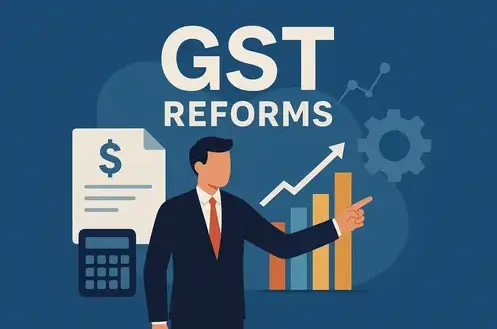
Introduction- GST Reforms
The Goods and Services Tax (GST) came into being in July 2017 as part of ‘One Nation, One Tax,’ as it replaced an existing system of indirect taxes and took tax uniformity across India to a whole new level. But the multiple tax slabs found in the GST framework complicated tax compliance. On September 21, 2025, Prime Minister Narendra Modi announced the ‘GST Bachat Utsav’, which proposed reforms to GST, including the introduction of a two-slab GST structure. These reforms are expected to ease compliance and enhance greater economic efficiency.
Constitutional Basis of GST
While GST was enacted into law by the 101st Constitutional Amendment Act of 2016 and followed a process of approval by parliament, two main Articles from the framework remain important:
Article 246A provides for the Centre and States to have ‘simultaneous powers’ to tax GST on the supply of goods and services. Therefore, Article 246A provides for a dual control over goods and services taxes by the Centre and States, all within a uniform tax base.
Article 279A establishes the GST Council; a unique example of cooperative federalism; a tax policy and administration partnership between the Centre and States.
The Centre compensates states for 5 years under GST Act 2017, funded by cess on luxury and sin goods. This compensatory payment solves States’ concerns about maintaining fiscal balance between taxes and expenditures while the new tax system stabilizes.
The Old GST Slabs
Since its launch, GST had five main tax slabs: 0%, 5%, 12%, 18%, and 28%. Some items carried special rates, like gold at 3% and rough diamonds at 0.25%
0%: Essential items such as fresh fruit, vegetables, and grains.
5%: Articles of daily use, such as packaged food items and transport services, and footwear costing less than ₹1,000.
12%: Processed food items, mobile phones, and travel by air (business class).
18%: Standard rate including every type of service, electronics, and everyday consumer goods.
28%: Luxury items and “sin goods,” including automobiles, tobacco, and aerated beverages.
Having five tax slabs caused classification issues, more compliance burdens, and costly, time-consuming litigation. It also made GST difficult to predict for both businesses and taxpayers.
GST Reform 2025: Two-Slab Structure
As of September 22, 2025, GST will now exists in two slabs, at 5% and 18%
- Items earlier at 12% GST are now 5%, aimed at boosting consumer spending.
- White goods and appliances move from 28% to 18% GST, easing costs for consumers and industries.
- PM Modi said GST reform will save ₹2.5 lakh crore yearly, benefiting middle class and small businesses.
Economic Implications
The revised GST structure with two slabs has both economic benefits and challenges. For consumers, basic goods will become cheaper which increases disposable income and savings.
- MSMEs will benefit from easier compliance and fewer disputes over classifications.
- The reform will improve ease of doing business.
- It will also make India more competitive globally.
- A challenge is harmonising Centre and State revenue losses.
- Luxury and sin goods may lose extra taxation.
- Inflation risks exist if rates take time to stabilise.
- Supply chain goods may face adjustment pressures.
- Despite concerns, experts call the reform a major step.
- It promotes efficiency, transparency, and a stronger tax regime.
Relevance for UPSC
For those pursuing UPSC, the relevance of GST (Reform 2025) is significant in terms of:
Prelims: Understand the GST Council with your knowledge of the relevant constitutional articles (246A, 279A) when considering the old and new slab structure.
Mains (GS-3): the topic of federalism to discuss indirect tax reform where the ease of doing business synopsis is relevant.
Essay: on Topic such as “Tax reform and an inclusive model for growth” you could use the topic of GST as a case study for an essay.
Questions from Past Year (PYQs): UPSC has previously tested the relevance of GST as part of an economy or type of governance or cooperative federalism relevance to the examination. For both prelims and mains it will aid UPSC examinees link current affairs with economic policy, aspects of constitutional governance is an important relationship that needs to be assessed!
Way Forward
To guarantee that the GST Reform of 2025 is a success, it is imperative to approach its implementation smoothly and engage in strong public awareness campaigns. States need to be provided compensatory funding amounts to ensure their revenue is protected through this transition. Policymakers should continue to monitor inflation rates and be ready to consider amending their policies should a sudden uptick in consumer prices necessitate action. Additionally, in the long-term, India may aspire to seek a unified GST slab that would further simplify tax payments and reduce compliance burdens. It is to be hoped that careful execution and ongoing cooperation between the Centre and States will deliver the reform’s anticipated economic and social benefits.
Read about differences between President and Vice-president elections.
Conclusiom
GST Reform of 2025 represents a pivotal moment for tax simplification in India. The number of slabs had reduced from multiple to just two, delicately balancing citizen affordability, government efficiency, and cooperative federalism. For UPSC aspirants, this reform is timely to add to their knowledge base not only for economy and policies questions, but also in polity, updated federalism, and current affairs areas, making it an all-encompassing for prelims and mains exam preparation.
Finally, the reform is indicative of India’s attempts to achieve a transparent, efficient, and equitable tax system while facilitating economic growth.
FAQ’s
GST, which stands for Goods and Services Tax, is an integrated indirect tax that has replaced a range of central and state taxes. GST was established in India in 2017 essentially as “One Nation, One Tax.” The intention behind GST is to ease the process of taxation, lessen the cascading effects, and improve compliance.
Prior to the reform in 2025, GST had five major slabs, which implemented rates of 0%, 5%, 12%, 18%, and 28%, plus other niche rates for certain items. All slab rates are based on the class/type of good or service.
The GST Council, which was created under Article 279A, is led by the Union Minister of Finance and consists of the Minister of Finance for each state. The GST Council recommends rates of GST, exemptions under GST, thresholds for registration, and handles disputes that arise between the Centre and states.
The new reform in 2025 introduced a two-slab GST with a 5% rate for essentials, and an 18% rate for most goods and services. Moreover, the change achieves compliance-based simplicity, and less time spent in disputes, and will introduce an estimated ₹2.5 lakh crore savings for consumers in total.
Under the GST (Compensation to States) Act, 2017 states will receive compensatory payments funded by a cess on luxury and sin goods. This act will protect state revenues for 5 years after the implementation of GST, ensuring the reforms will go smoo

